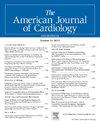Sirolimus-Coated Balloon Versus Drug-Eluting Stent in Elderly Patients With Coronary Artery Disease: A Matched-based Comparison
IF 2.1
3区 医学
Q2 CARDIAC & CARDIOVASCULAR SYSTEMS
引用次数: 0
Abstract
Coronary artery disease (CAD) is the leading cause of mortality in elderly patients (≥75 years). While percutaneous coronary intervention (PCI) with second-generation drug-eluting stents (DES) is commonly used in elderly patients with CAD, drug-coated balloons (DCB) have emerged as a promising alternative. The aim of this study was to compare the safety and efficacy of PCI with Sirolimus-Coated Balloons (SCB) and second-generation DES in this population. We included elderly patients who underwent PCI from the prospective, investigator-driven EASTBOURNE study (n= 534 patients treated with Magic Touch SCB) and the Complex Registry (n = 234 patients treated with second-generation DES). The primary endpoint was net adverse cardiovascular events (NACE), a composite of all-cause death, target lesion revascularization (TLR), nonfatal myocardial infarction (MI), and major bleedings at the 2-year follow-up. The cardinality score matching and Cox regression analysis were employed. After matching, 220 patients were included in each group. The incidence of NACE was similar between groups (HR 1.28; 95% CI: 0.85–1.93; p = 0.239). No significant differences were observed in the rates of nonfatal MI, or TLR. However, the SCB group exhibited a significantly lower rate of the secondary BARC 3–5 bleeding endpoint compared to the DES group (HR 0.17; 95% CI: 0.04–0.77; p = 0.030). In conclusion, CI with SCB demonstrated comparable safety and efficacy to second-generation DES in elderly patients with CAD at 2-year follow-up, with a notable reduction in major bleeding risk in the SCB group.
西罗莫司涂层球囊与药物洗脱支架在老年冠心病患者中的应用:基于匹配的比较
冠状动脉疾病(CAD)是老年患者(≥75岁)死亡的主要原因。虽然经皮冠状动脉介入治疗(PCI)与第二代药物洗脱支架(DES)通常用于老年CAD患者,但药物涂层气球(DCB)已成为一种有希望的替代方案。本研究的目的是比较PCI与西罗莫司包覆气囊(SCB)和第二代DES在该人群中的安全性和有效性。我们纳入了来自前瞻性、研究者驱动的EASTBOURNE研究(n= 534例接受Magic Touch SCB治疗的患者)和Complex Registry (n = 234例接受第二代DES治疗的患者)的接受PCI的老年患者。主要终点是2年随访期间的净不良心血管事件(NACE),包括全因死亡、靶病变血运重建术(TLR)、非致死性心肌梗死(MI)和大出血。采用基数评分匹配和Cox回归分析。配对后,每组纳入220例患者。两组间NACE发生率相似(HR 1.28;95% ci: 0.85-1.93; = 0.239页)。在非致死性心肌梗死或TLR发生率方面没有观察到显著差异。然而,与DES组相比,SCB组显示次要BARC 3-5出血终点的发生率显著降低(HR 0.17;95% ci: 0.04-0.77; = 0.030页)。总之,在随访2年的老年CAD患者中,SCB CI与第二代DES的安全性和有效性相当,SCB组的大出血风险显著降低。
本文章由计算机程序翻译,如有差异,请以英文原文为准。
求助全文
约1分钟内获得全文
求助全文
来源期刊

American Journal of Cardiology
医学-心血管系统
CiteScore
4.00
自引率
3.60%
发文量
698
审稿时长
33 days
期刊介绍:
Published 24 times a year, The American Journal of Cardiology® is an independent journal designed for cardiovascular disease specialists and internists with a subspecialty in cardiology throughout the world. AJC is an independent, scientific, peer-reviewed journal of original articles that focus on the practical, clinical approach to the diagnosis and treatment of cardiovascular disease. AJC has one of the fastest acceptance to publication times in Cardiology. Features report on systemic hypertension, methodology, drugs, pacing, arrhythmia, preventive cardiology, congestive heart failure, valvular heart disease, congenital heart disease, and cardiomyopathy. Also included are editorials, readers'' comments, and symposia.
 求助内容:
求助内容: 应助结果提醒方式:
应助结果提醒方式:


